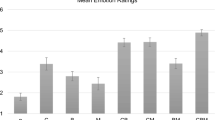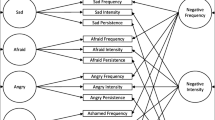Abstract
Recent research has indicated strong relations between people's appraisals of their circumstances and their emotional states. The present study examined these relations across a range of unpleasant situations in which subjects experienced complex emotional blends. Subjects recalled unpleasant experiences from their pasts that were associated with particular appraisals and described their appraisals and emotions during these experiences. Situations defined by particular appraisals along the human agency or situational control dimensions were reliably associated with different levels of anger, sadness, and guilt, as predicted. However, predicted differences in emotion were not observed for situations selected for appraisals along the certainty or attention dimensions. Most subjects reported experiencing blends of two or more emotions, and correlation/regression analyses indicated that even in the context of these blends, patterns of appraisal similar to those observed previously (Smith & Ellsworth, 1985, 1987) characterized the experience of the individual emotions. The regressions further indicated that appraisals along some dimensions were more important to the experience of particular emotions than were appraisals along other dimensions. Thesecentral appraisals are compared with the adaptive functions their associated emotions are believed to serve, and the implications of these findings are discussed.
Similar content being viewed by others
References
Abelson, R. P. (1983). Whatever became of consistency theory?Personality and Social Psychology Bulletin, 9 37–54.
Arnold, M. B. (1960).Emotion and personality (2 vols.). New York: Columbia University Press.
Cannon, W. B. (1927). The James-Lange theory of emotion: A critical examination and an alternative theory.American Journal of Psychology, 39 106–124.
Cannon, W. B. (1929).Bodily changes in pain, hunger, fear, and rage (2nd ed.). New York: Appleton-Century.
Carlsmith, J. M., & Gross, A. E. (1969). Some effects of guilt on compliance.Journal of Personality and Social Psychology, 11 232–239.
Cohen, S., Sherrod, D. R., & Clark, M. S. (1986). Social skills and the stress protective role of social support.Journal of Personality and Social Psychology, 50 963–973.
Coyne, J. (1976). Toward an interactional description of depression.Psychiatry, 39 28–40.
D'Andrade, R. G. (1981). The cultural part of cognition.Cognitive Science, 5 179–195.
Darwin, C. (1965).The expression of the emotions in man and animals. Chicago: University of Chicago Press. (Original work published 1872)
Ellsworth, P. C., & Smith, C. A. (1987).Models and memories of emotion: A comparison of their associated appraisals and facial expressions. Unpublished manuscript, Stanford University.
Folkman, S., & Lazarus, R. S. (1980). An analysis of coping in a middle-aged community sample.Journal of Health and Social Behavior, 21 219–239.
Folkman, S., & Lazarus, R. S. (1985). If it changes it must be a process: Study of emotion and coping during three stages of a college examination.Journal of Personality and Social Psychology, 48 150–170.
Folkman, S., Lazarus, R. S., Dunkel-Schetter, C., DeLongis, A., & Gruen, R. J. (1986). The dynamics of a stressful encounter: Cognitive appraisal, coping, and encounter outcomes.Journal of Personality and Social Psychology, 50 992–1003.
Freedman, J. L., Wallington, S. A., & Bless, E. (1967). Compliance without pressure: The effect of guilt.Journal of Personality and Social Psychology, 7 117–124.
Frijda, N. H., (1986).The emotions. Cambridge: Cambridge University Press.
Frijda, N. H. (1987). Emotion, cognitive structure, and action tendency.Cognition and Emotion, 1 115–143.
Izard, C. E. (1972).Patterns of emotions. New York: Academic Press.
Izard, C. E. (1977).Human emotions. New York: Plenum.
James, W. (1950).The principles of psychology (Vol. 2). New York: Dover. (Original work published 1890)
Konečni, V. J. (1972). Some effects of guilt on compliance: A field replication.Journal of Personality and Social Psychology, 23 30–32.
Lazarus, R. S. (1968). Emotions and adaptation: Conceptual and empirical relations. In W. J. Arnold (Ed.),Nebraska symposium on motivation, 1968 (pp. 175–266). Lincoln: University of Nebraska Press.
Lazarus, R. S. (1982). Thoughts on the relations between emotion and cognition.American Psychologist, 37 1019–1024.
Lazarus, R. S., Kanner, A. D., & Folkman, S. (1980). Emotions: A cognitive-phenomenological analysis. In R. Plutchik & H. Kellerman (Eds.),Emotion: Theory, research, and experience: Vol. 1. Theories of emotion (pp. 189–217). New York: Academic Press.
Leeper, R. W. (1948). A motivational theory of emotion to replace “emotion as disorganized response.”Psychological Review, 55 5–21.
McGraw, K. M. (1987). Guilt following transgression: An attribution of responsibility approach.Journal of Personality and Social Psychology, 53 247–256.
Milgram, S. (1974).Obedience to authority. New York: Harper & Row.
Plutchik, R. (1980).Emotion: A psychoevolutionary synthesis. New York: Harper & Row.
Regan, D. T., Williams, M., & Sparling, S. (1972). Voluntary expiation of guilt: A field experiment.Journal of Personality and Social Psychology, 24 42–45.
Roseman, I. J. (1984). Cognitive determinants of emotions: A structural theory, in P. Shaver (Ed.),Review of personality and social psychology: Vol. 5, Emotions, relationships, and health (pp. 11–36). Beverly Hills: Sage.
Rosenthal, R., & Rosnow, R. L. (1985).Contrast analysis: Focused comparisons in the analysis of variance. New York: Cambridge University Press.
Russell, D. (1982). The Causal Dimension Scale: A measure of how individuals perceive causes.Journal of Personality and Social Psychology, 42 1137–1145.
Russell, D., & McAuley, E. (1986). Causal attributions, causal dimensions, and affective reactions to success and failure.Journal of Personality and Social Psychology, 50 1174–1185.
Scherer, K. R. (1984). On the nature and function of emotion: A component process approach. In K. R. Scherer & P. Ekman (Eds.),Approaches to emotion (pp. 293–317). Hillsdale, NJ: Erlbaum.
Schwartz, G. E., & Weinberger, D. A. (1980). Patterns of emotional responses to affective situations: Relations among happiness, sadness, anger, fear, depression, and anxiety.Motivation and Emotion, 4 175–191.
Smith, C. A. (1987). The informational structure of the facial expression of emotion.Dissertation Abstracts International, 47, 4002B. (University Microfilms No. 87-00,820)
Smith, C. A., & Ellsworth, P. C. (1985). Patterns of cognitive appraisal in emotion.Journal of Personality and Social Psychology, 48 813–838.
Smith, C. A., & Ellsworth, P. C. (1987). Patterns of appraisal and emotion related to taking an exam.Journal of Personality and Social Psychology, 52 475–488.
Tomkins, S. S. (1963).Affect, imagery, consciousness: Vol. 2. The negative affects. New York: Springer.
Wallington, S. A. (1973). Consequences of transgression: Self-punishment and depression.Journal of Personality and Social Psychology, 28 1–7.
Weiner, B. (1985). An attributional theory of achievement motivation and emotion.Psychological Review, 92 548–573.
Weiner, B., Graham, S., & Chandler, C. (1982). Pity, anger, and guilt,Personality and Social Psychology Bulletin, 8 226–232.
Zimbardo, P. G. (1970). The human choice: Individuation, reason and order versus deindividuation, impulse and chaos. In N. J. Arnold & D. Levine (Eds.),Nebraska symposium on motivation (pp. 237–307). Lincoln: University of Nebraska Press.
Author information
Authors and Affiliations
Additional information
This research was supported in part by a Stanford University graduate fellowship and in part by a National Institute of Mental Health training grant to Craig Smith. Part of the writing was done while Phoebe Ellsworth was a fellow at the Center for Advanced Study in the Behavioral Sciences, supported by the John D. and Catherine T. MacArthur Foundation and by the James McKeen Cattell Fund.
Rights and permissions
About this article
Cite this article
Ellsworth, P.C., Smith, C.A. From appraisal to emotion: Differences among unpleasant feelings. Motiv Emot 12, 271–302 (1988). https://doi.org/10.1007/BF00993115
Issue Date:
DOI: https://doi.org/10.1007/BF00993115




